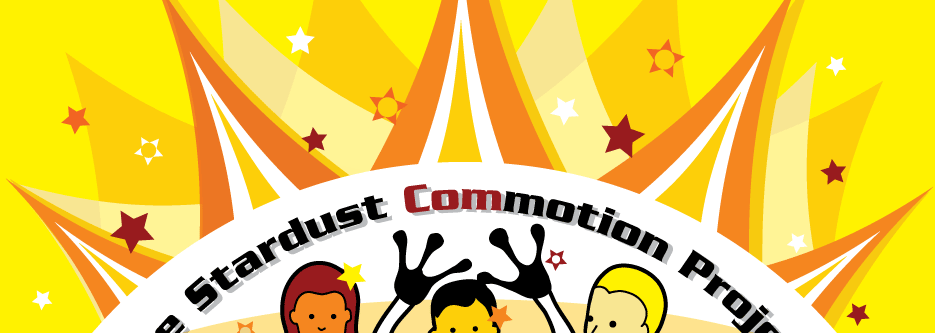 |
 |
 |
 |
 |
Our goal is to encourage body awareness and social interaction through open-ended performances. We’re developing networked costume modules that function as musical instruments. Performers gesture and move to generate and vary musical tones. Through improvised play, sensing costumes, and network technologies, we invite freeform collaboration. |
 |
 |
 | Our project foregrounds materiality. Key to each performance is the body in motion, social engagement, theatrical play and amplifying, integrated technologies. We encourage participants to explore the interactive and acoustic potential of a shared space. The performance becomes a mediated happening; performers and costumes combine in a fluid composition.
|  |
 |
 |
We are encouraging personal expression in a particular place. We’ve chosen Atlanta’s Piedmont Park as our performance site. The park is a central city park with a dynamic mix of people. We’ll invite park visitors to wear costume modules and form a temporary band. |
 |
 |
 | Each costume module takes the form of a creature, inspired by the behavior and form of insects, arachnids and amphibians. Costume modules are activated by performers as they gesture and move.
|  |
 |
 | A costume has its own unique aural quality—a particular pitch, tone and duration. A participant plays a sound by manipulating her creature appendages.
|
 |
 |
 | 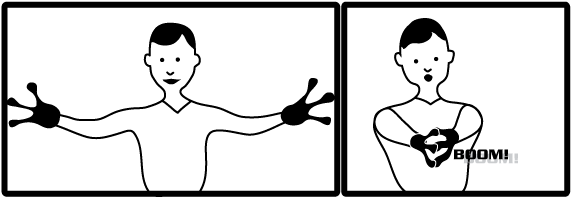 |
 |
 |
Clap frog hands to trigger a low-pitched, drum-like boom sound. |
 |
 |
 |
Sound volume is amplified by moving through the space. Move up a hill and sound volume scales up; move down a hill and volume decreases. |
 |
 |
 | 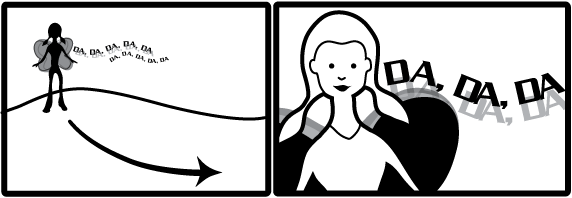 |
 |
 | Move forward to increase the volume of modulating sound generated by flapping butterfly wings. |
 |
 |
 | Sound pitch is altered by interaction with other participants. When a player approaches another player, the difference in pitch is diminished. When two players stand right next to each other, both players’ pitches are identical. As the players move apart, their pitches scale back to their original tone.
|  |
 |
 | 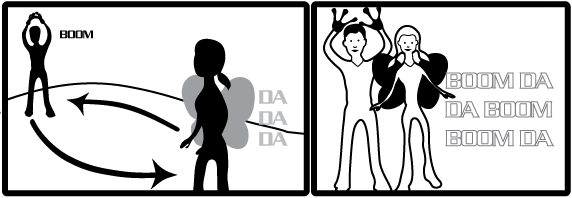 |
 |
 |
Low-pitch frog sound and high-pitched butterfly sound both move to a middle-pitch range as the performers come close to each other. |
 |
 |
 |
By manipulating appendages, moving through the space, and engaging with other participants, players create harmonious, chaotic or conflicting sounds. |
 |
 |
 | Each performer-creature takes on a complementary role:
|  |
 |
 |
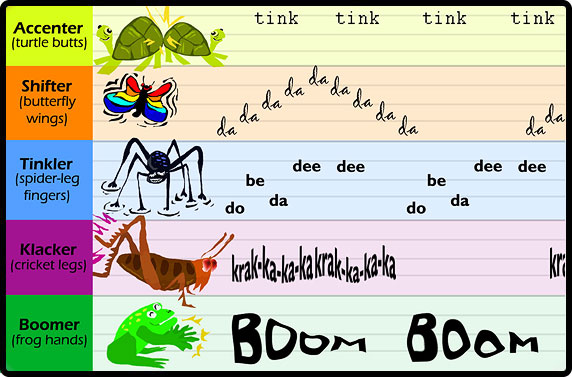 |
 |
 |
 |
We view the project as an ongoing process. We’ll watch and learn from the group dynamics; noting the expectations and explorations of participants. Over time we’ll adjust the project to incorporate our observations, encourage alternative performances, and expand the range of interaction. Our philosophy is to encourage negotiated, improvised interaction with full-body movement, tangible interfaces, and networked environments. |
 |
 |
 |
TEAM MEMBERS
Steven Hodges
Brian Schrank
Geoffrey Thomas |
 |
 |
 |
| PREVIOUS PROJECTS |
 |
 |
 |
Participatory Body Instruments, 2007
Participatory Body Instruments use gesture and movement to alter the “music” of images and sounds. |
 |
 |
 |
Mashboard Games, 2005-7
The common computer keyboard is used as a musical instrument and game interface to loosen our entrenched (non)perceptions of the hardware through play. |
 |
 |
 |
Luminet Technologies, 2007
A parody of an ethically challenged upstart company. The first company offering, I'm Always Near, sends comforting, corporate sponsored messages to your cell-phone based on location; it was developed using J2ME, Java Web Services and GPS technologies. |
 |
 |
 |
Left To My Own Devices, 2003-4
Left To My Own Devices uses the codes of digital games to explore a narrative of loss and awkward renewal. It merges experimental, interactive animation with online games. |
|
 |
 |
 |
 |
| TIMELINE |
 |
| May 15th First Milestone |
| Design |
|
Refine initial interaction desgn documents
Experiment with materials:
build paper and digital 3D models
Explore sound arrangements |
 |
| June 1st Second Milestone |
| Basic Prototyping |
|
Input Hardware: photocell, flex sensor, infrared, microphone, pressure sensors, Lilypad Arduino boards
Network Hardware: blue tooth modems
Network Software: Processing, Java
Integration: Combining hardware and software into a single system
|
 |
| August 1st Third Milestone |
| Phase 1 Module Prototyping: Sound generation through costume module manipulation |
|
Butterfly Wings: Generate musical scales when wings open and close.
Integration: Flex sensor data (from wings) with tone generation
Frog Hands: Generate boom sound when hands clap.
Integration: 80% darkness in photocell in frog palms generate tone
Spider-leg Fingers: Generate piano tinkling when fingers tap surface.
Integration: 80% darkness in photocell in finger tips generate tones
|
 |
| October 1st Fourth Milestone |
| Phase 2 Module Prototyping: Sound generation through costume module manipulation |
| Cricket Legs: Generate percussive clacking when legs rub together
Integration: Pressure sensor data generates tone
Turtle Butts: Generate a ding when turtle butts hit together.
Integration: 80% darkness in photocell in side of butt shell generate tones
Stress test all modules
|
 |
| December 1st Fifth Milestone |
| Full Harmonic Integration: Integrate costume module output and spatial input |
|
Moving across the space affects volume
Proximity of modules averages their pitches |
 |
| Feburary 1st Sixth Milestone |
| PerformanceTesting / Stress Testing |
 |
| April 1st Set-up for Performances |
| Three Spring Performances |
| April 4th Piedmont Park Performance (by children’s play area) |
| April 18th Georgia Tech Park |
| May 2nd Piedmont Park |
| |
| |
|
 |
 |
 |  |  |
 |  |  |  |
| BUDGET ESTIMATE |
| Materials |
| Quantity |
| Price |
| Total |
| Flex Sensors |
|
10 |
| 12.95 | |
129.50 |
 |
| Photocells |
| 20 | |
1.50 |
|
30.00 |
 |
| Infrared Sensors |
| 20 | | 34.95 | |
699.00 |
 |
| Lilypad Arduino Main Board |
| 10 | | 19.95 | |
199.50 |
 |
| Lilypad Arduino Power Supply |
| 10 | | 14.95 | |
149.50 |
 |
| Bluetooth USB Modem |
| 10 | | 64.95 | |
649.50 |
 |
| Laptop |
| 1 | |
already own |
| |
 |
| Electrical Wire, Solder, Boards, Resistors |
|
|
|
|
|
160.00 |
 |
| Conductive Thread |
|
2 |
|
20.00 |
|
40.00 |
 |
| Paint |
| |
|
|
|
120.00 |
 |
| Paper-mache materials |
| |
|
|
|
80.00 |
 |
| Alminum wire |
| |
|
|
|
50.00 |
 |
| Body Harness |
|
5 |
|
35.00 |
|
175.00 |
 |
| Fabric |
| |
|
|
|
250.00 |
 |
| Speakers |
| 2 | |
250.00 |
|
500.00 |
 |
| Amplifier |
|
|
|
|
|
150.00 |
 |
| Generator |
|
1 |
|
|
|
450.00 |
 |
| Materials Total |
|
|
|
|
|
$3,832.00 |
 |
 |
| Labor |
| Hours |
| Rate |
| Total |
| Sound Designer |
|
60 |
|
20.00 |
|
1200.00 |
 |
| Visual Designer |
|
60 |
|
20.00 |
|
1200.00 |
 |
| Programmer |
|
220 |
|
20.00 |
|
4400.00 |
 |
| Fabricator |
|
200 |
|
20.00 |
|
4000.00 |
 |
| Labor Total |
|
|
|
|
|
$10,800.00 |
 |
 |
 |
| Final Total |
|
|
|
|
|
$14,632.00 |
 |
 |
| The project has no outside funding sources at this time. |
 |
|
|
 |
|
 |










